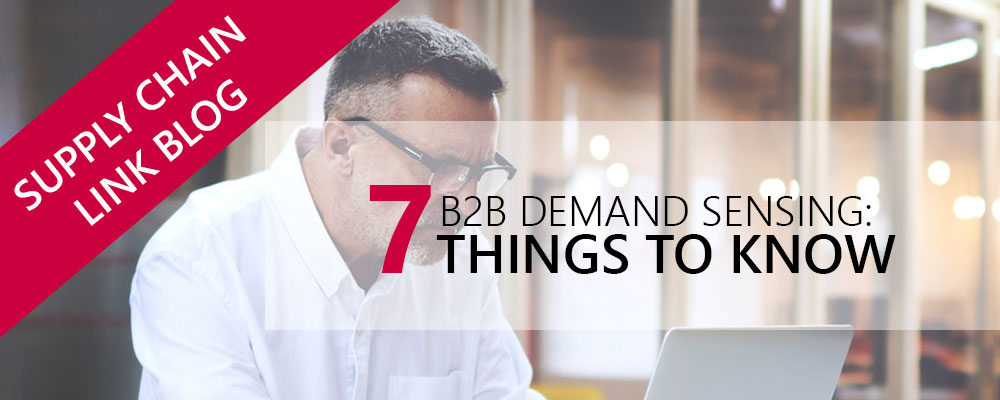
What are the key things to know about B2B demand sensing?
In our upcoming webinar on B2B Demand Sensing, we will discuss practical examples of how upstream manufacturers are using B2B Demand sensing to reduce inventory costs and identify additional sales opportunities.
In this blog post, we will discuss fundamental information that B2B manufacturers looking to improve forecast accuracy with demand sensing should know.
In most companies, the supply chain planning processes are geared towards a monthly cycle. While this induces discipline in overall planning, there is a constant tension between what was planned for the month and the immediate situation. The demand that is planned for may or may not materialize.
In today’s environment of low inventories and rapid changes, the plan must constantly be adapted to external changes. A key aspect of this is to make sure that manufacturing assets and inventory are deployed effectively to meet demand even if the demand changes constantly.
Many of the companies that we work with are positioned early within the overall supply chain. In a typical supply chain, we may have an ingredient manufacturer who sells to a part manufacturer who in turn sells to a module manufacturer who then sells to a final product manufacturer. The final product then enters the distribution chain where it might pass through a distributor, regional warehouses, stores, and finally to the end customer. As shown below.
7 Things to Know About B2B Demand Sensing
1. What is Demand Sensing?
Demand sensing is a robust forecasting method that involves using historical data, near-term market signals such as POS data, changes in the weather and market conditions, to improve forecast accuracy for inventory planning.
[Read Also: Customer-Centric Supply Chain Planning: The Difference is in the Details]2. How Demand Sensing is Different from The Traditional Sales Forecast?
Traditional forecasting systems that use historical data as a basis are limited because historical data does not reflect current conditions or events. However, historical data can provide more than just the volume that was sold. A careful analysis of historical data can include information on order patterns, a customer’s material usage, co-products, and highlight sales opportunities.
While POS data is valuable in improving the demand signal at the tail end of the supply chain, the value of the POS data decreases as you move upstream in the supply chain. The significance of any changes in the POS data is lost due to the intermediate planning processes of the upstream layers, and the inventory buffers between layers.
Key Differences between B2B Demand Sensing and Traditional Forecasting:
- Traditional forecasting is usually based Point of Sale Data (POS) only
- Mostly historical (not real-time or near real-time)
- Does not consider current market conditions
- May ignore weather impact and other social changes
3. Most Demand Sensing Applications Are Not Geared Towards B2B Manufacturers
In most demand sensing applications, the emphasis is on detecting and reacting to changes at the customer level. Often this is called the point of sale (POS) data. Traditional forecasting systems that use historical data as a basis are limited because historical data does not reflect current conditions or events. However, historical data can provide more than just the volume that was sold. A careful analysis of historical data can provide information on order patterns, a customer’s material usage, co-products, and highlight sales opportunities.
[You May Also Like: A Five-Step Approach to Effective Demand Planning Implementation]4. What is The Bullwhip Effect?
The bullwhip effect is a concept for explaining inventory fluctuations or inefficient asset allocation as a result of demand changes as you move further up the supply chain. As such, upstream manufacturers often experience a decrease in forecast accuracy as the buffer increases between the customer and the manufacturer. Based on the most recent US Bureau of Census data, the total inventory between the customer and a manufacturer two to three layers upstream may be as high as 6 months of sales. So, real changes at the point of sales may not be relevant to material requirements for the manufacturer who is upstream.
5. The Value of POS Data Diminishes as You Move Upstream
As mentioned previously, while POS data is valuable in improving the demand signal at the tail end of the supply chain, the value of the POS data decreases as you move upstream in the supply chain. The significance of any changes in the POS data is lost due to the intermediate planning processes of the upstream layers, and the inventory buffers between layers.
[Related: Let’s Talk – Demand Planner to Account Executive]6. How Can Upstream Manufacturers Use Historical Data?
For manufacturers, upstream in the supply chain, careful analysis of the historical data that is commonly available and comparing it to the current local situation yields better results for improving the short-term demand. Commonly available data includes:
- Sales History
- Open Order History
- Current open orders
- Customers buying pattern for a product
- Products Being Bought Together
7. Upstream Manufacturers Should Use Time Lag to Help Detect Long Term Market Shifts
For detecting longer term market shifts, upstream manufacturers have an advantage because of the lag time in the supply chain caused by intermediate inventory buffers. A change in the market or environment is going to affect the demand close to the customer almost immediately. However, the same change is going to affect the upstream manufacturer with a time lag which depends on the size of the intermediate buffers. This lag allows upstream manufacturers to use economic indicators and other external factors to modify asset allocation well in advance of when the change has a material effect on them.
Join our upcoming webinar on B2B demand sensing for more practical examples of how B2B businesses are using demand sensing to optimize inventory levels and increase bottom line results. Register here.
Enjoyed this post? Subscribe or follow Arkieva on Linkedin, Twitter, and Facebook for blog updates.





